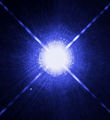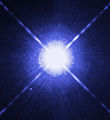From Wikipedia, the free encyclopedia
 Size of this preview: 439 × 479 pixels
Size of this preview: 439 × 479 pixels Full resolution (1,280 × 1,398 pixels, file size: 160 KB, MIME type: image/jpeg)
 |
This is a file from the Wikimedia Commons. The description on its description page there is shown below.Commons is a freely licensed media file repository. You can help.
|
| Description |
This Hubble Space Telescope image shows Sirius A, the brightest star in our nighttime sky, along with its faint, tiny stellar companion, Sirius B. Astronomers overexposed the image of Sirius A [at centre] so that the dim Sirius B [tiny dot at lower left] could be seen. The cross-shaped diffraction spikes and concentric rings around Sirius A, and the small ring around Sirius B, are artifacts produced within the telescope's imaging system. The two stars revolve around each other every 50 years. Sirius A, only 8.6 light-years from Earth, is the fifth closest star system known. |
| Source |
http://www.spacetelescope.org/images/html/heic0516a.html |
| Date |
15 Oct., 2003 |
| Author |
NASA, ESA
Credit: H. Bond (STScI) and M. Barstow (University of Leicester) |
Permission
( Reusing this image) |
see below
|
 |
This file is in the public domain because it was created by the European Space Agency and NASA. Hubble material is copyright-free and may be freely used as in the public domain without fee, on the condition that ESA and NASA is credited as the source of the material. The material was created for ESA by the Hubble European Space Agency Information Centre and for NASA by STScI under Contract NAS5-26555. or . |
|
File history
Click on a date/time to view the file as it appeared at that time.
|
|
Date/Time |
Thumbnail |
Dimensions |
User |
Comment |
| current |
18:34, 12 December 2007 |
 |
1,280×1,398 (160 KB) |
DENker |
|
|
|
12:42, 25 December 2005 |
 |
369×403 (143 KB) |
Superborsuk |
|
File links
The following pages on Schools Wikipedia link to this image (list may be incomplete):




